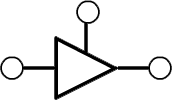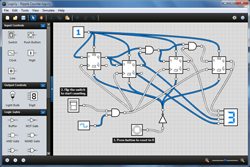Tri-State Buffer
| Enable Input | Input A | Output |
|---|---|---|
| false | false | hi-Z |
| false | true | hi-Z |
| true | false | false |
| true | true | true |
A tri-state buffer is similar to a buffer, but it adds an additional "enable" input that controls whether the primary input is passed to its output or not. If the "enable" inputs signal is true, the tri-state buffer behaves like a normal buffer. If the "enable" input signal is false, the tri-state buffer passes a high impedance (or hi-Z) signal, which effectively disconnects its output from the circuit.
Tri-state buffers are often connected to a bus which allows multiple signals to travel along the same connection.
The truth table for a tri-state buffer appears to the right.
Symbols
The symbol below can be used to represent a tri-state buffer.
| Tri-State Buffer |
|---|
 |
Live Example
Try the following interactive example to see for yourself how a tri-state buffer behaves.
Further Reading
To learn more, check out the following external resources:
Three-state logic on Wikipedia
Special output gates on All About Circuits
Simulate with Logicly
Logicly provides an engaging, hands-on learning environment for teaching logic gates and circuits. Download the Free 30-Day Trial today to evaluate Logicly in your classroom or lab. Learn More »


